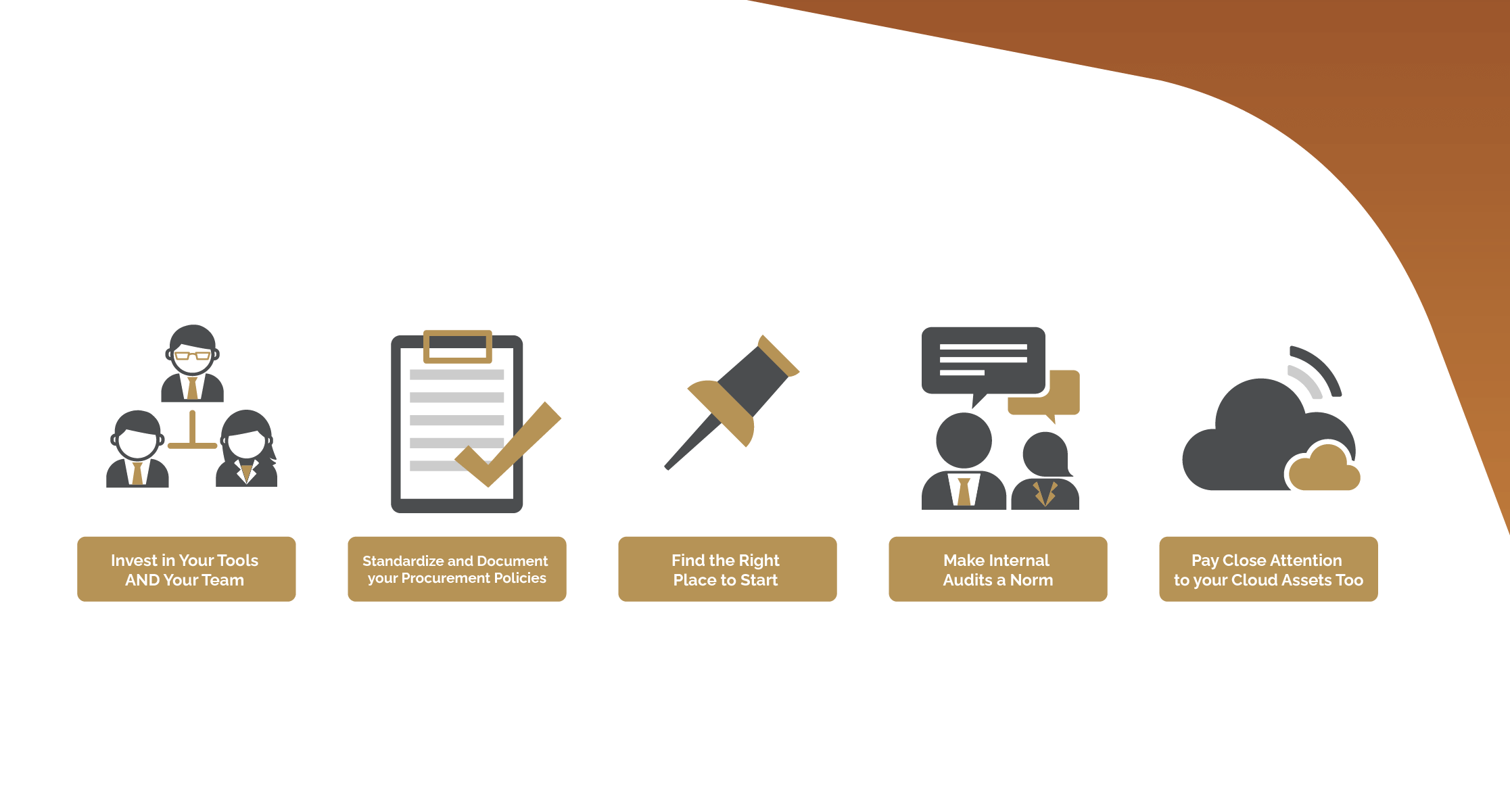BLOG
See How Easily You Can Simplify Your Software Asset Management Journey [5 Best Practices]
Software Asset Management will help optimize your spending and keep your organization audit-ready. Here are some best practices that you should adopt.
As organizations everywhere start to recover from the global impact of the pandemic, innovation leaders have started to take it on themselves to implement initiatives that will serve their enterprise’s recovery.
In most cases, this has to do with more than spearheading technological projects that will create a conducive environment for team members. Asset managers, for example, play an active role in ensuring that expenses are tempered and that existing assets are maximized. Innovation projects are also being deployed to protect organizations from unwanted and unnecessary expenditures that arise from significant audit findings.
Now more than ever, implementing a comprehensive Software Asset Management workflow has become a priority for any organization. Investing in the right SAM program has also become a top concern, especially for big organizations that need to work with mountains of data and licenses.

Software Asset Management, especially when done without the help of a consultant or a managed service provider, can be pretty intimidating.
But it doesn’t have to be.
As long as you have the right tools and systems — backed up by the right people equipped with the right skills to maximize them — you should be able to reap sizable rewards from your SAM investments.
Here are five of the best SAM practices that will simplify your journey towards SAM maturity. Make use of these guidelines and implement them in your enterprise to bring yourself closer to your software optimization and compliance goals.

Invest in Your Software Asset Management Tools – AND Your Team
Deploying the right SAM tool is important, but using them is not enough. Enterprises should also pay attention to investing in the right personnel who will ensure that all licenses are up-to-date and that all software assets are being used to their maximum benefit.
Your SAM team is the internal group of champions who will keep track of all application usage and ensure that your business needs are supported by the right software and cloud assets. They will also play an integral role in aligning all software-related processes and policies with new employees.
Thus, it is integral that they are not only equipped with the technical skills to use the SAM program that you will deploy. They should also be able to serve as the rallying force that will help you create a culture of compliance within your organization.
Leadership also plays an important role in implementing a SAM for your business. On top of equipping your SAM team with the tools and skills that they need to do the job right, all Software Asset Management goals and priorities should also be vetted — and supported — by those who hold the reins of your enterprise.
Standardize and Document your Software Asset Management Policies
More than being ready to receive and process software procurement requests, your SAM team should be guided by standardized policies that will help your organization avoid unnecessary overlaps and expenses.
In addition, all asset procurement processes should be backed and supported by a procurement strategy that ensures long-term cost efficiency and risk management.
On top of standardizing the overall procurement process, it is highly recommended that you get all the necessary guidelines documented and indoctrinated throughout your organization. Remember, your SAM journey is not a one-off project. It heavily relies on performing every step of the process properly, all the time. Documenting your procurement policies – and ensuring that it is followed to a T – will amplify the benefits that you can expect from your SAM implementation.
Find the Right Place to Start in your Software Asset Management Journey
The first phase of your SAM journey could be intimidating, especially if your organization is just starting with digitalizing this practice. For some organizations, figuring out which process to begin implementing or which step to take first can be a cause for concern.
To make this part of the process more manageable, ask yourself a simple question: Which area of your software ecosystem bears the highest potential for risks? Which area has the biggest potential for software wastage? Where could you possibly be least compliant?
Since the overarching goal of SAM is to help your enterprise optimize your software spending, it will be wise to target problem areas where you may be burning financial investments. Do an internal survey of actual usage and compare them to your latest spending. Once you begin with that area of your ecosystem, you will soon find yourself naturally making your way through the rest of your assets.
Make Internal Audits a Norm and a Software Asset Management Must-Have
What’s amazing about modern SAM programs is their capacity to automate tasks that have to do with recording license usage, updates, configurations, and compliance. Without one, your team will need to spend around a month putting together the necessary documents for an audit.
What most organizations need to understand though, is that there is absolutely nothing that is stopping them from taking an extra step that will protect them from unwanted audit-related liabilities. Instead of relying solely on external audits to maintain compliance, regular internal audits should also be performed on a regular basis.
Take a big picture view of the benefits that internal audits can bring you. In addition to helping you maintain license compliance, regular internal audits are also opportunities for you to drill down on your assets and pinpoint possible areas of license inactivities and redundancies.
With the right SAM programs, you should be able to perform a regular gap analysis to identify the software and cloud tools that you use and to check licensing on each one of them. On top of this, you can perform a compliance analysis to identify – and address – over or under-licensing your software.
Pay Close Attention to your Cloud Assets Too
One of the common mistakes that organizations commit when they do SAM is focusing solely on software management on physical devices.
To reap the maximum benefits from your SAM efforts, you also need to look into non-physical locations like virtual environments and cloud repositories. If you allocate a certain percentage of your resources to these cloud assets, then it warrants that you include them in the audits that you perform.
This way, you will be able to pinpoint possible optimization areas there, too, while ensuring that all team members who need access to them are also able to make the most use of them.
The right Software Asset Management practices and tools will bring myriads of benefits to an organization. However, designing a SAM process and protocol that addresses the enterprise’s pain points is not the simplest feat.
For organizations who are still working their way towards SAM maturity, working with consultants and managed service providers is a rewarding way to ensure that all the right practices are put into place.
Unikomm, the first ServiceNow partner in GCC, is one of the top ServiceNow consultants in Saudi Arabia. We have a team of SAM specialists who can help organizations make the most out of their SAM implementations. For expert advice on optimizing your software spend and ensuring license compliance, schedule a call with our consultant today.
For more information on why – and how – you can digitalize the other areas of your enterprise, read more here.
LATEST RESOURCES
AI Virtual Agents: The Quickest and Easiest Way to Address Service Concerns
Automated Service Mapping: Your Powerful Secret to a Service-Aware Infrastructure
Why Top KSA Enterprises are Investing in the Best CSM Software (And Why You Should Too)
Employee Self-Service | 5 Tips to Help your Team Embrace It
Enterprise GRC: 4 Emerging GRC Trends for your Post-Pandemic Recovery
Transform your Digital Aspirations Today.
Get on a call with your dedicated Unikomm consultant
Take ahold of content made for IT practitioners who refuse to be left out.